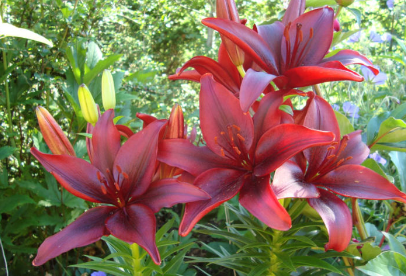
The Black Out Lily (Lilium ‘Black Out’) is part of the Division I Asiatic hybrid lily group. Usually Asiatic lilies are among the first lilies to bloom in the summer, starting their floral display in June and continuing for several weeks. Unlike other lilies, Asiatic lilies generally have little to no fragrance. Flowers bloom in June-July on rigid stems rising 2-3’ tall. Stems are clad with narrow, lanceolate, dark green leaves.
Black Out lily was introduced to the commercial market in the early 2000s. Since its introduction it has been distributed everywhere and sold through nurseries, garden centers, and online plant retailers. It is a hybrid between Asiatic lilies and potentially Oriental lilies. Black Out’ features funnel-shaped, dark carmine red flowers with darker black-flushed-red shading in the center of each petal. The flowers are large about 5 inches in diameter. They also have a velvety texture. It blooms in early to mid-summer.
Characteristics of Black Out Lily
- Size: The Black Out Lily reaches a height of 2 to 3 feet. It has an upright growth habit with sturdy stems that support the large blooms.
- Growth Habit: This lily has a clump-forming growth habit, with multiple stems emerging from a single bulb.
- Growth Rate: It has a moderate growth rate. Once planted, they will establish themselves within the first year and should reliably produce blooms year after after.
- Flower: Flower: Features funnel-shaped, dark carmine-red flowers with darker black-flushed-red shading in the center of each petal.
- Flower Orientation: The flowers are upward-facing.
- Bloom Time: The lily blooms in early to mid-summer, usually from June to July. Each flower lasts for about one to two weeks.
- Fragrance: Unlike some other lilies, the Black Out Lily has a mild fragrance.
- USDA Zone: It thrives in USDA Hardiness Zones 5-9. This means it can withstand winter temperatures as low as -20°F (-28.9°C).
- Lifespan: It is a perennial plant and will return year after year with proper care.
- Disease Resistance: Potential diseases include lily mosaic virus and bulb rot. Plants may need staking if grown in too much shade or in locations exposed to strong winds.
Cultivation Tips
Planting
- Timing: Plant the bulbs in the fall (ideally 6 weeks before the ground freezes) or early spring.
- Location: Choose a spot with full sun to part shade. Ideally, the top part of the plant should receive sunlight, while the roots benefit from cooler soil.
- Soil: Black Out Lilies prefer well-drained, average to medium moisture soil that’s rich in organic matter. Amending the soil with compost before planting is beneficial.
- Depth: Plant the bulbs at a depth of 4-6 inches, with the pointed end facing upwards.
- Containers: If planting in pots, ensure they have good drainage holes. You can plant the bulbs anytime between spring and fall.
Care
- Watering: Water regularly throughout the growing season, maintaining consistent moisture in the soil. Avoid letting the soil dry out completely, but be mindful of overwatering as it can lead to bulb rot.
- Mulching: Apply a 2-3 inch layer of mulch around the base of the plant to retain moisture, regulate soil temperature, and suppress weeds.
- Fertilizing: You can fertilize lightly in the spring with a balanced fertilizer to encourage growth. Avoid over-fertilizing as it can harm the bulbs.
- Deadheading: Once the flowers fade, deadhead them by removing the spent blooms. This prevents seed formation and encourages the plant to focus its energy on bulb growth for the following year.
- Winter Care: In colder climates (USDA zones 5-6), you may want to cover the planting area with mulch or straw in late fall to protect the bulbs from harsh winter temperatures.